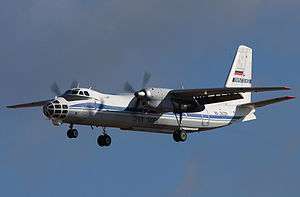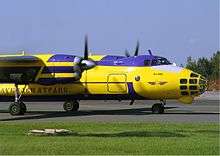Antonov An-30
| An-30 | |
|---|---|
 | |
| Role | Aerial cartography Aircraft and reconnaissance and transport |
| Manufacturer | Antonov |
| Designer | Beriev |
| First flight | 21 August 1967[1][2] |
| Introduction | July 1968 |
| Status | Limited service |
| Primary users | Ukrainian Air Force Bulgarian Air Force Romanian Air Force |
| Produced | 1971–1980[2] |
| Number built | 123[2] |
| Developed from | Antonov An-24 |
The Antonov An-30 (NATO reporting name: Clank), is a development of the An-24 designed for aerial cartography.
Development
The first aerial survey version of the Antonov An-24 was designed by the Beriev OKB and designated An-24FK. The FK stood for fotokartograficheskiy (photo mapping).[3] The prototype was converted from a production An-24A at Beriev's No. 49 construction shop during 1966. The An-24FK made its first flight on 21 August 1967, with state acceptance trials being completed in 1970 and civil certification completed in 1974. Redesignated An-30, production began in 1971 at the Antonov.[2] 123 production An-30s were manufactured between 1971 and 1980[4] in Kiev in 2 main versions.
Total production
| Total Production[5][6] | 1979 | 1978 | 1977 | 1976 | 1975 | 1974 | 1973 |
|---|---|---|---|---|---|---|---|
| 124 | 8 | 13 | 27 | 24 | 27 | 17 | 8 |
Design

The Antonov An-30 is a derivative of the An-24 fitted with an entirely new fuselage forward of frame 11. The fuselage nose is extensively glazed, reminiscent of the Boeing B-29. Housed within the new nose section is the navigator and precise navigational equipment, including an optical sight for ensuring accuracy of aerial photography.[3] To enable accurate and repeatable survey flights, standard equipment for the An-30 included computer flight path control technology.[7] This additional equipment replaced the radar. The positioning of the new navigational equipment required the flightdeck to be raised by 41 cm in comparison to the An-24,[3] giving the aircraft its other main feature, a hump containing the cockpit, similar to the Boeing 747.
The radio operator and flight engineer sat in the first cabin aft of and below the flightdeck. The mission equipment was located further aft, in a cabin featuring five camera windows in the floor. Each camera window could be closed with covers to protect the glass panels. The covers were located in special fairings protruding from the fuselage underside. In the normal aerial photography role, four or five cameras were carried aboard. Three cameras were mounted vertically, intended for mapping purposes. The remaining two cameras were pointed at an angle of 28° on each side of the aircraft, for oblique photography. The same fuselage compartment contained workstations for two camera operators and a crew rest area.[8]
The aircraft's cameras could be used between 2,000 and 7,000 m (6,500 and 23,000 ft) and the scale of the resultant photographs was between 1:200,000 and 1:15,000,000.[2] The aircraft was supplied with four or five cameras.
The An-30 was powered by two Ivchenko AI-24VT turboprops with a take-off rating of 2,820 ehp.[2]
Operational history

As well as its principal use as a survey aircraft, it has also been used by Bulgaria, Czech Republic, Romania, Russia and Ukraine to carry out surveillance under the Open Skies Treaty.
The An-30 has also been used as a weather control aircraft as the An-30M. Some have been fitted with frozen tanks of carbon dioxide to be ejected into the sky to form artificial rain clouds. These An-30s have also been put to use to avoid crop-damaging hailstorms and also to maintain good weather for, as examples, new airplane maiden flights, important parades like the 1st of May and the 850th anniversary of Moscow in September 1997.[9]
Between 1971 and 1980 a total of 115 aircraft were built and 23 were sold abroad to Afghanistan, Bulgaria, China, Cuba, Czechoslovakia, Mongolia and Vietnam.
An-30s completely mapped Afghanistan in 1982, with one shot down by a MANPADS during an aerial photography flight in the Kabul area south of the Panjshir Valley on 11 March 1985. Cuban An-30s saw active service in Angola in 1987.
On 22 April 2014, a Ukrainian An-30 was hit by small arms fire while on a surveillance mission over the town of Sloviansk in Eastern Ukraine, which was being held by pro-Russian separatists. The plane landed safely with minor damage.[10] On 6 June 2014, a Ukrainian An-30B was shot down near the city of Slavyansk in eastern Ukraine, reportedly by a MANPADS fired by local separatists.[11]
Accidents
On 23 May 2012 Russian Open Skies Antonov-30 caught fire during an emergency landing at an airport outside the Czech city of Caslav. According to unconfirmed reports, the accident occurred because the crew was unable to extend the landing gear. Seven passengers were injured, out of 14 Russian and 9 Czech citizens on board.[12]
Variants
- An-24FK
- The sole prototype converted from an An-24B with a navigators station in an extensively glazed nose and elevated cockpit to give clearance for mission equipment.
- An-30A
- Version designed for civilian aviation. 65 were delivered to the Soviet Ministry of Civil Aviation, 6 to other Soviet civil organisations. 18 An-30As were built for export, 7 of which were delivered to China.[13]
- An-30B
- Version designed for the Soviet Air Force. 26 built. Main differences from An-30A was the avionics fit. Most An-30Bs were retro-fitted with chaff/flare dispensers.[14]
- An-30D Sibiryak
- Long range version of the An-30A with increased fuel capacity, developed in 1990. 5 aircraft were converted to An-30Ds. All were based at Myachkovo airfield near Moscow. This variant was used for ice monitoring, fisheries monitoring and as a transport aircraft. It had improved communication equipment, including a data-link system. Rescue equipment was also carried on board.[15]
- An-30FG
- Czech designation for the single Czech Air Force An-30, after being retro-fitted with a western weather radar.[15]
- An-30M Meteozashchita
- Version equipped for weather research. It can spray dry ice into the atmosphere for weather control duties. The dry ice was stored in 8 containers per 130 kg instead of the photographic equipment.
- An-30R
- A production An-30 CCCP-30055/RA-30055(c/n1101) converted to a NBC reconnaissance aircraft with air sampling pods under the forward fuselage and other sensors for monitoring nuclear, biological and chemical warfare by-products. A second example, 30080, was acquired by the VVS, differing in having only one sampling pod on the port pylon and provision for dropping large flare bombs from the starboard pylon. An-30R RA-30055 was used for monitoring the plume from the Chernobyl No.4 nuclear reactor fire and became permanently radio-active in the process, being withdrawn from use immediately afterwards.
Operators


Military operators
- Romanian Air Force – 3 operated from 1976; currently 2[18]
Former Military operators
- Afghan Air Force received an An-30 in 1985.
- Czech Air Force retired their An-30 in 2003.
Civil operators
 Congo
Congo
- Aero-Fret
Former civil operators
- Moskovia Airlines
- Lukiaviatrans
- Myachkovo Air Services
- Novosibirsk Air Enterprise
- Polet Airlines
- Practical Geodinamics Center
- ARP 410 Airlines
- Ukraine National Airlines
Specifications (An-30)
Data from Jane's All The World's Aircraft 1988–89[19]
General characteristics
- Crew: 7
- Length: 24.26 m (79 ft 7 in)
- Wingspan: 29.20 m (95 ft 9½ in)
- Height: 8.32 m (27 ft 3½ in)
- Wing area: 75 m² (807 ft²)
- Aspect ratio: 11.4:1
- Empty weight: 15,590 kg (34,370 lb)
- Max. takeoff weight: 23,000 kg (50,706 lb)
- Powerplant: 2 × ZMKB Progress AI-24T turboprops, 2,103 kW (2,803 ehp) each
Performance
- Maximum speed: 540 km/h (291 knots, 335 mph)
- Cruise speed: 430 km/h (232 knots, 267 mph)
- Range: 2,630 km (1,420 nm, 1,634 mi)
- Service ceiling: 8,300 m (27,230 ft)
Avionics
5 positions for large cameras. Other survey equipment can be fitted.
See also
- Related development
- Aircraft of comparable role, configuration and era
- Related lists
References
Notes
- ↑ The prototype aircraft (a converted An-24 designated An-24FK) first flew on 21 August 1967. The first production An-30 first flew in 1974
- 1 2 3 4 5 6 Gordon, Komissarov and Komissarov 2003, p. 75.
- 1 2 3 Gordon, Komissarov and Komissarov 2003, p. 73.
- ↑ Gunston, Bill (1995). The Osprey Encyclopedia of Russian Aircraft from 1875 – 1995. Osprey Aerospace. ISBN 1-85532-405-9.
- ↑ "✈ russianplanes.net ✈ наша авиация".
- ↑ "Antonov An -30 Aerial Car Aerial Cartography Aircraft - Air Force Technology". Air Force Technology. Kable Intelligence LTD. Retrieved 9 November 2015.
- ↑ Green, W (1976). The Observer's Book of Aircraft (25th ed.). Frederick Warne & Co. ISBN 0-7232-1553-7.
- ↑ Gordon, Komissarov and Komissarov 2003, p. 74.
- ↑ M J H Taylor, ed. (1999). Brassey's World Aircraft & Systems Directory 1999/2000 Edition. Brassey's. ISBN 1-85753-245-7.
- ↑ "Ukraine crisis: Biden says Russia must 'start acting' - BBC News".
- ↑ "Самолет-разведчик сбили над Славянском ополченцы - Телеканал «Звезда»".
- ↑ "Another Russian plane tragedy".
- ↑ Gordon, Komissarov and Komissarov 2003, p. 77.
- ↑ Gordon, Komissarov and Komissarov 2003, p. 80.
- 1 2 Gordon, Komissarov and Komissarov 2003, p. 83.
- ↑ "Flying Flying - Scramble". scramble.nl. Retrieved 19 May 2015.
- ↑ "Успешно облитане на Ан-30 за удължаване на ресурса - Авиация - Pan.bg".
- ↑ "Romanian Armed Forces Equipment". European Defense Inventory. Armed Forces.co.uk. Retrieved 22 April 2014.
- ↑ J W R Taylor, ed. (1988). Jane's All The World's Aircraft,1988–89. Jane's Information Group. ISBN 0-7106-0867-5.
http://russianplanes.net/planelist/Antonov/An-30
Bibliography
- Yefim Gordon, Dmitriy Komissarov and Sergey Komissarov (2003) Antonov's Turboprop Twins. Hinckley, UK: Midland Publishing. ISBN 1-85780-153-9
External links
| Wikimedia Commons has media related to Antonov An-30. |